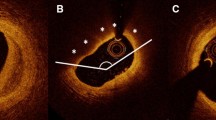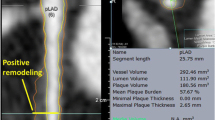Abstract
Previous studies have reported a circadian variation in the onset of ST-segment elevation myocardial infarction (STEMI). However, underlying mechanisms for the circadian variation have not been fully elucidated. We investigated the relationship between onset of STEMI and the underlying pathology using optical coherence tomography (OCT). Patients with a diagnosis of STEMI were selected from a multicenter OCT registry. Patients were divided into 4 groups based on the estimated time of onset (00:00–05:59, 06:00–11:59, 12:00–17:59, or 18:00–23:59). Underlying pathologies of MI (plaque rupture, plaque erosion, and calcified plaque) were compared among the 4 groups. Among 648 patients, plaque rupture was diagnosed in 386 patients (59.6%), plaque erosion in 197 patients (30.4%), and calcified plaque in 65 patients (10.0%). A marked circadian variation was detected in the incidence of plaque rupture with a peak at 09:00, whereas it was not evident in plaque erosion or calcified plaque. The probability of plaque rupture significantly increased in the periods of 06:00–11:59 [odds ratio (OR) 2.13, 95% confidence interval (CI) 1.30–3.49, p = 0.002] and 12:00–17:59 (OR 2.10, 95% CI 1.23–3.58, p = 0.005), compared to the period of 00:00–05:59. This circadian pattern was observed only during weekdays (p = 0.010) and it was not evident during the weekend (p = 0.742). Plaque rupture occurred most frequently in the morning and this circadian variation was evident only during weekdays. Acute MI caused by plaque rupture may be related to catecholamine surge.



Similar content being viewed by others
References
Vedanthan R, Seligman B, Fuster V (2014) Global perspective on acute coronary syndrome: a burden on the young and poor. Circ Res 114(12):1959–1975
Bhaskaran K, Hajat S, Haines A, Herrett E, Wilkinson P, Smeeth L (2010) Short term effects of temperature on risk of myocardial infarction in England and Wales: time series regression analysis of the Myocardial Ischaemia National Audit Project (MINAP) registry. BMJ 341:c3823
Mohammad MA, Karlsson S, Haddad J et al.(2018) Christmas, national holidays, sport events, and time factors as triggers of acute myocardial infarction: SWEDEHEART observational study 1998–2013. BMJ 363:k4811
Muller JE, Stone PH, Turi ZG et al.(1985) Circadian variation in the frequency of onset of acute myocardial infarction. N Engl J Med 313:1315–1322
Hjalmarson A, Gilpin EA, Nicod P et al.(1989) Differing circadian patterns of symptom onset in subgroups of patients with acute myocardial infarction. Circulation 80(2):267–275
Holmes DR, Aguirre FV, Aplin R et al.(2010) Circadian rhythms in patients with ST-elevation myocardial infarction. Circulation 3(4):382–389
Willich SN, Linderer T, Wegscheider K, Leizorovicz A, Alamercery I, Schroder R (1989) Increased morning incidence of myocardial infarction in the ISAM Study: absence with prior beta-adrenergic blockade. ISAM Study Group Circulation 80(4):853–858
Tofler GH, Muller JE, Stone PH et al.(1992) Modifiers of timing and possible triggers of acute myocardial infarction in the Thrombolysis in Myocardial Infarction Phase II (TIMI II) Study Group. J Am Coll Cardiol 20(5):1049–1055
Falk E, Nakano M, Bentzon JF, Finn AV, Virmani R (2013) Update on acute coronary syndromes: the pathologists' view. Eur Heart J 34(10):719–728
Jia H, Abtahian F, Aguirre AD et al.(2013) In vivo diagnosis of plaque erosion and calcified nodule in patients with acute coronary syndrome by intravascular optical coherence tomography. J Am Coll Cardiol 62(19):1748–1758
Ibanez B, James S, Agewall S et al.(2018) 2017 ESC Guidelines for the management of acute myocardial infarction in patients presenting with ST-segment elevation: The Task Force for the management of acute myocardial infarction in patients presenting with ST-segment elevation of the European Society of Cardiology (ESC). Eur Heart J 39(2):119–177
Shiomi H, Nakagawa Y, Morimoto T et al.(2012) Association of onset to balloon and door to balloon time with long term clinical outcome in patients with ST elevation acute myocardial infarction having primary percutaneous coronary intervention: observational study. BMJ 344:e3257
Cannon CP, Gibson CM, Lambrew CT et al.(2000) Relationship of symptom-onset-to-balloon time and door-to-balloon time with mortality in patients undergoing angioplasty for acute myocardial infarction. JAMA 283(22):2941–2947
Eagle KA, Nallamothu BK, Mehta RH et al.(2008) Trends in acute reperfusion therapy for ST-segment elevation myocardial infarction from 1999 to 2006: we are getting better but we have got a long way to go. Eur Heart J 29(5):609–617
Kubo T, Imanishi T, Takarada S et al.(2007) Assessment of culprit lesion morphology in acute myocardial infarction. J Am Coll Cardiol 50(10):933–939
Jang I-K, Tearney GJ, MacNeill B et al.(2005) In vivo characterization of coronary atherosclerotic plaque by use of optical coherence tomography. Circulation 111(12):1551–1555
Higuma T, Soeda T, Abe N et al.(2015) A combined optical coherence tomography and intravascular ultrasound study on plaque rupture, plaque erosion, and calcified nodule in patients with ST-segment elevation myocardial infarction: incidence, morphologic characteristics, and outcomes after percutaneous coronary intervention. JACC Cardiovasc Interv 8(9):1166–1176
Dai J, Xing L, Jia H et al.(2018) In vivo predictors of plaque erosion in patients with ST-segment elevation myocardial infarction: a clinical, angiographical, and intravascular optical coherence tomography study. Eur Heart J 39(22):2077–2085
Sugiyama T, Yamamoto E, Fracassi F et al.(2019) Calcified plaques in patients with acute coronary syndromes. JACC Cardiovasc Interv 12(6):531–540
Tearney GJ, Regar E, Akasaka T et al.(2012) Consensus standards for acquisition, measurement, and reporting of intravascular optical coherence tomography studies: a report from the international working group for intravascular optical coherence tomography standardization and validation. J Am Coll Cardiol 59(12):1058–1072
Weitzman ED, Fukushima D, Nogeire C, Roffwarg H, Gallagher TF, Hellman L (1971) Twenty-four hour pattern of the episodic secretion of cortisol in normal subjects. J Clin Endocrinol Metab 33(1):14–22
Tofler GH, Brezinski D, Schafer AI et al.(1987) Concurrent morning increase in platelet aggregability and the risk of myocardial infarction and sudden cardiac death. N Engl J Med 316(24):1514–1518
Panza JA, Epstein SE, Quyyumi AA (1991) Circadian variation in vascular tone and its relation to alpha-sympathetic vasoconstrictor activity. N Engl J Med 325(14):986–990
Millar-Craig MW, Bishop CN, Raftery EB (1978) Circadian variation of blood-pressure. Lancet 1(8068):795–797
Fukumoto Y, Hiro T, Fujii T et al.(2008) Localized elevation of shear stress is related to coronary plaque rupture: a 3-dimensional intravascular ultrasound study with in-vivo color mapping of shear stress distribution. J Am Coll Cardiol 51(6):645–650
Li ZY, Taviani V, Tang T et al.(2009) The mechanical triggers of plaque rupture: shear stress vs pressure gradient. Br J Radiol 82(1):S39–45
Mittleman MA, Mostofsky E (2011) Physical, psychological and chemical triggers of acute cardiovascular events: preventive strategies. Circulation 124(3):346–354
Andreotti F, Davies GJ, Hackett DR et al.(1988) Major circadian fluctuations in fibrinolytic factors and possible relevance to time of onset of myocardial infarction, sudden cardiac death and stroke. Am J Cardiol 62(9):635–637
Ehrly AM, Jung G (1973) Circadian rhythm of human blood viscosity. Biorheology 10(4):577–583
Keatinge WR, Coleshaw SR, Cotter F, Mattock M, Murphy M, Chelliah R (1984) Increases in platelet and red cell counts, blood viscosity, and arterial pressure during mild surface cooling: factors in mortality from coronary and cerebral thrombosis in winter. Br Med J (Clin Res Ed) 289(6456):1405–1408
Partida RA, Libby P, Crea F, Jang IK (2018) Plaque erosion: a new in vivo diagnosis and a potential major shift in the management of patients with acute coronary syndromes. Eur Heart J 39(22):2070–2076
Pedicino D, Vinci R, Giglio AF et al.(2018) Alterations of hyaluronan metabolism in acute coronary syndrome: implications for plaque erosion. J Am Coll Cardiol 72(13):1490–1503
Murakami S, Otsuka K, Kubo Y et al.(2004) Repeated ambulatory monitoring reveals a Monday morning surge in blood pressure in a community-dwelling population. Am J Hypertens 17(12 Pt 1):1179–1183
Robertson D, Johnson GA, Robertson RM, Nies AS, Shand DG, Oates JA (1979) Comparative assessment of stimuli that release neuronal and adrenomedullary catecholamines in man. Circulation 59(4):637–643
Moncada S, Vane JR (1979) Arachidonic acid metabolites and the interactions between platelets and blood-vessel walls. N Engl J Med 300(20):1142–1147
Ogston D (1964) Fibrinolytic activity and anxiety and its relation to coronary artery disease. J Psychosom Res 8:219–222
Green LH, Seroppian E, Handin RI (1980) Platelet activation during exercise-induced myocardial ischemia. N Engl J Med 302(4):193–197
Estelles A, Tormo G, Aznar J, Espana F, Tormo V (1985) Reduced fibrinolytic activity in coronary heart disease in basal conditions and after exercise. Thromb Res 40(3):373–383
Levine SP, Towell BL, Suarez AM, Knieriem LK, Harris MM, George JN (1985) Platelet activation and secretion associated with emotional stress. Circulation 71(6):1129–1134
Naghavi M, Libby P, Falk E et al.(2003) From vulnerable plaque to vulnerable patient. Circulation 108(14):1664–1672
Sibley DR, Lefkowitz RJ (1985) Molecular mechanisms of receptor desensitization using the beta-adrenergic receptor-coupled adenylate cyclase system as a model. Nature 317(6033):124–129
Hofstetter A, Schutz Y, Jequier E, Wahren J (1986) Increased 24-hour energy expenditure in cigarette smokers. N Engl J Med 314(2):79–82
Hansen O, Johansson BW, Gullberg B (1992) Circadian distribution of onset of acute myocardial infarction in subgroups from analysis of 10,791 patients treated in a single center. Am J Cardiol 69(12):1003–1008
Ridker PM, Manson JE, Buring JE, Muller JE, Hennekens CH (1990) Circadian variation of acute myocardial infarction and the effect of low-dose aspirin in a randomized trial of physicians. Circulation 82(3):897–902
Jia H, Dai J, Hou J et al.(2017) Effective anti-thrombotic therapy without stenting: intravascular optical coherence tomography-based management in plaque erosion (the EROSION study). Eur Heart J 38(11):792–800
Acknowledgements
Ik-Kyung Jang’s research was supported by Mr. Michael and Mrs. Kathryn Park and by Mrs. Gill and Mr. Allan Gray. We are grateful to Iris McNulty, RN (Massachusetts General Hospital) for coordination and editorial work.
Author information
Authors and Affiliations
Corresponding authors
Ethics declarations
Conflict of interest
Ik-Kyung Jang has received educational grants from Abbott Vascular. They had no role in the design or conduct of this research. All other authors have reported that they have no relationships relevant to the contents of this paper to disclose.
Ethical approval
All procedures performed in studies involving human participants were in accordance with the ethical standards of the institutional and/or national research committee and with the 1964 Helsinki declaration and its later amendments or comparable ethical standards.
Additional information
Publisher's Note
Springer Nature remains neutral with regard to jurisdictional claims in published maps and institutional affiliations.
Electronic supplementary material
Below is the link to the electronic supplementary material.
Rights and permissions
About this article
Cite this article
Araki, M., Yonetsu, T., Kurihara, O. et al. Circadian variations in pathogenesis of ST-segment elevation myocardial infarction: an optical coherence tomography study. J Thromb Thrombolysis 51, 379–387 (2021). https://doi.org/10.1007/s11239-020-02220-6
Published:
Issue Date:
DOI: https://doi.org/10.1007/s11239-020-02220-6




